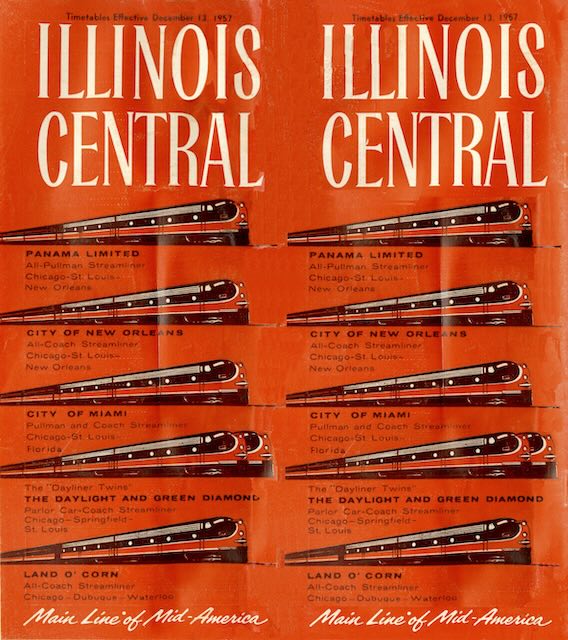The all-Pullman Panama Limited, Illinois Central’s premiere train, took 16-1/2 hours between Chicago and New Orleans for an average speed of nearly 56 miles per hour. It probably could have been a little faster if it didn’t have cars added and taken off from it at various points along the way.
 Click image to download a 16.8-MB PDF of this timetable.
Click image to download a 16.8-MB PDF of this timetable.
Two cars from St. Louis were added to the southbound train at Carbondale. At Memphis a car was added while a car from Chicago was taken off the train at Jackson, Mississippi. Since the train had an observation car, the cars couldn’t just be added or taken off the rear of the train so all of these required multiple switching moves and probably added close to 30 minutes to the train’s schedule.
The all-coach City of New Orleans had a similar schedule and also had cars added or taken off from it at Carbondale, but not Memphis or Jackson. Two other trains between Chicago and New Orleans were the Louisane, which had sleeping cars only between Chicago and Memphis, and the coach-only with no food services Southern Express. The Louisane took 20 hours, 35 minutes, partly because it made about two dozen more stops than the Panama while the Southern Express was scheduled to take 10 minutes less than the Louisane even though it made 43 more stops than the Louisane (though some were only flag stops).
IC’s other major long-distance route was to Florida. In 1957, this was served by the streamlined City of Miami, which went every other day (up from every third day a few months before), and the still-heavyweight but daily Seminole. Both trains went IC to Birmingham, Central of Georgia to Albany, GA, then Atlantic Coast Line to Jacksonville. Cars from the City of Miami continued to Tampa and St. Petersburg on ACL and to Miami on FEC.
After picking up a couple of cars from St. Louis in Carbondale, the City of Miami carried 11 sleepers, four coaches, a twin-unit diner, and a lounge-observation car to Florida. The train took 24-1/2 hours to get to Jacksonville. The equipment list for the Seminole only includes two coaches and two sleepers (one of which only went as far south as Birmingham) plus a combined diner-lounge car. That train took 27-1/2 hours to get to Jacksonville.
This timetable includes condensed schedules lettered A, B, F, G, H, I, and L. Clearly, some are missing. Consultation with the 1950 timetable indicates that table C was Memphis connections with Rock Island trains to Little Rock and Hot Springs, Arkansas. The IC trains that made those connections still ran but either the Rock Island trains did not or schedules had changed to make connections impossible. Similarly, table D showed connections at Jackson between the Panama Limited and a train to Shreveport. The trains still ran in 1957 but the Panama schedule had changed so the connection was no longer possible.
Table E was IC’s attempt to compete with Louisville & Nashville in the Cincinnati-New Orleans market with trains between Louisville and New Orleans that connected with B&O trains from Cincinnati. By 1957 IC’s Louisville-New Orleans trains were off the timetable.
Table J in 1950 was a Memphis-Vicksburg train called the Delta Express. By 1957 this had been replaced by a bus. There was no table K in 1950 so it must have been a route deleted before that year.
Although IC had a line from Chicago to Omaha, it had the second-longest route of the five or six railroads in that corridor so it had given up on that service. It still had two trains a day to Waterloo, Iowa, one of which went on to Sioux City. Finally, it continued to compete in the hotly contested Chicago-St. Louis market with three daily trains.
